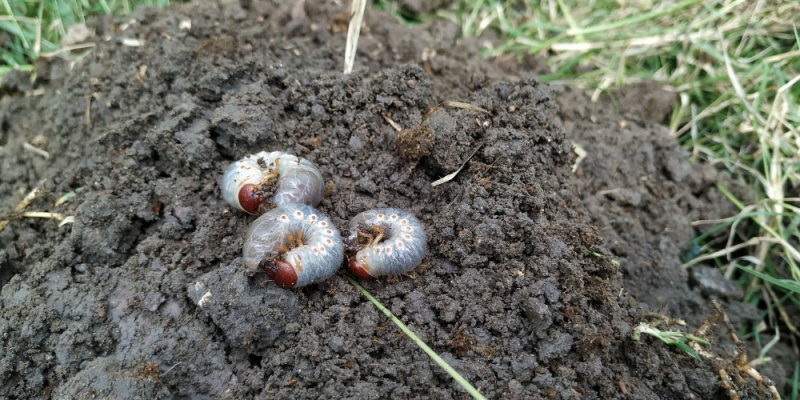Lawn grubs can wreak havoc on your lawn in Canal Winchester, leaving unsightly brown patches and weakening your grass. If your lawn has suffered damage from grubs, prompt and effective repair is essential to restore its lush appearance and resilience. In this blog, we’ll guide you through the steps to repair lawn damage caused by grubs, ensuring your Canal Winchester lawn returns to its vibrant state.
Understanding Grub Damage
Lawn grubs are the larvae of various beetle species, including Japanese beetles, June beetles, and European chafers. These grubs feed on the roots of grass, causing the grass to wilt, yellow, and eventually die. The damage often results in bare or thin patches that are prone to weed invasion and further deterioration.
Assessing the Extent of the Damage
Before initiating repair efforts, it’s crucial to assess the severity of the grub damage:
- Identify the Affected Areas:
Walk across your lawn and note any brown or dead patches. Use the spongy turf test (walking barefoot) to identify areas where the grass feels soft.
- Confirm Grub Presence:
Inspect the affected areas by digging up a small section of turf to look for visible grubs. If grubs are present, proceed with treatment and repair.
Step-by-Step Guide to Repair Grub Damage
1. Treat the Grub Infestation
Before repairing the lawn, it’s essential to eliminate the remaining grubs to prevent further damage:
- Chemical Treatments:
Apply an appropriate grub control insecticide according to the manufacturer’s instructions. It’s best to treat in late summer or early fall when grubs are actively feeding.
- Biological Controls:
Consider using beneficial nematodes or milky spore disease, which are natural predators of grubs and can help reduce their population without harming your lawn or the environment.
2. Remove Damaged Grass
Once the grub infestation is treated, remove the damaged grass to make way for new growth:
- Raking:
Use a rake to remove dead grass and debris from the affected areas. This process, known as dethatching, helps to clear the area and prepare the soil for reseeding.
- Aeration:
Aerate the soil in the damaged areas to improve soil structure, enhance nutrient uptake, and promote healthy root growth.
3. Prepare the Soil
Proper soil preparation is crucial for successful lawn repair:
- Soil Testing:
Conduct a soil test to determine nutrient deficiencies and pH levels. Adjust the soil accordingly by adding lime or sulfur to balance pH and incorporating necessary fertilizers.
- Topdressing:
Apply a thin layer of compost or topsoil to enrich the soil and provide a fertile environment for new grass seeds to germinate.
4. Reseed the Damaged Areas
Reseeding is essential to fill in bare patches and restore lawn density:
- Choose the Right Grass Seed:
Select a grass seed variety that matches your existing lawn and is well-suited to Canal Winchester’s climate. Consider factors like drought tolerance, shade resistance, and wear tolerance.
- Seeding Technique:
Spread the grass seed evenly over the prepared soil using a seed spreader. For best results, use a higher seeding rate to ensure thorough coverage and reduce the likelihood of weed invasion.
5. Water and Care for the New Seedlings
Proper watering and care are vital for the successful establishment of new grass:
- Watering Schedule:
Water the seeded areas lightly but frequently to keep the soil consistently moist until the grass seedlings are established. Gradually reduce the frequency of watering as the grass grows.
- Fertilization:
Apply a balanced fertilizer to provide essential nutrients for the new grass. Avoid over-fertilizing, which can promote weed growth and stress the grass.
- Mowing:
Once the new grass reaches about 3 inches in height, mow it to encourage dense growth. Set the mower to a higher setting to avoid stressing the young grass.
6. Maintain a Healthy Lawn
Prevent future grub infestations and promote a resilient lawn through ongoing maintenance:
- Regular Mowing:
Maintain your grass at the recommended height to promote healthy growth and shade the soil, reducing weed seed germination.
- Proper Watering:
Water deeply and infrequently to encourage strong root development. Avoid overwatering, which can create favorable conditions for grubs and other pests.
- Fertilization:
Follow a regular fertilization schedule based on your soil test results to keep your lawn well-nourished and resilient against pests and diseases.
- Pest Monitoring:
Regularly inspect your lawn for signs of grub activity and other pests. Early detection allows for timely intervention, preventing extensive damage.
When to Seek Professional Help
While DIY lawn repair can be effective for minor grub damage, severe infestations may require professional assistance:
- Extensive Damage:
If large areas of your lawn are severely damaged, professional lawn care services can provide comprehensive treatment and repair solutions.
- Persistent Grub Issues:
Professionals can implement integrated pest management strategies to effectively control grub populations and prevent future infestations.
- Expertise and Equipment:
Lawn care professionals have access to specialized tools and high-quality products that can enhance the success of your lawn repair efforts.
Repairing lawn damage caused by grubs in Canal Winchester, OH, requires a systematic approach that includes treating the infestation, preparing the soil, reseeding, and maintaining a healthy lawn. By following these steps, you can restore your lawn’s lush appearance and resilience, ensuring it remains a beautiful and inviting space for your home. If you find that you do not have the time or expertise to deal with grubs on your own, reach out to the pros at Weed Busters for help.

